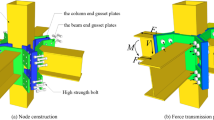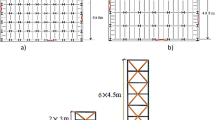Abstract
New energy absorption devices have been developed for use in net-type debris flow protection systems. The capacity of the anchors in the system needs careful analysis because the anchors play a significant role in transmitting energy from the impacting debris to the ground. In this paper, an effective method is proposed for estimating the anchor capacity based on increasing energy levels and the effect of brake frames in the system. For this purpose, four test cases based on varying impact energy levels were developed and full-scale impact tests were performed. The maximum deformations and tensile forces developed in the system were recorded and analyzed. Thereafter, the performance of the net protection system in the presence and absence of brake frames was numerically analyzed using ABAQUS software, and the stress distribution in various system components was investigated. Based on the results of the full-scale impact tests and numerical analysis, a relationship between the total anchor capacity and impact energy level was established by considering the workability of the U-clips. This study demonstrates that approximately 40% reduced anchor capacity can be safely used for impact energy levels ranging from 50 to 200 kJ when brake frames are used in the system.
Similar content being viewed by others
References
Abaqus G (2011) Dassault systèmes simulia corp. Providence, RI USA, Version 6.11
Ferrero A, Segalini A, Umili G (2015) Experimental tests for the application of an analytical model for flexible debris flow barrier design. Engineering Geology 185:33–42, DOI: https://doi.org/10.1016/j.enggeo.2014.12.002
Gentilini C, Gottardi G, Govoni L, Mentani A, Ubertini F (2013) Design of falling rock protection barriers using numerical models. Engineering Structures 50:96–106, DOI: https://doi.org/10.1016/j.engstruct.2012.07.008
Gentilini C, Govoni L, de Miranda S, Gottardi G, Ubertini F (2012) Three-dimensional numerical modelling of falling rock protection barriers. Computers and Geotechnics 44:58–72, DOI: https://doi.org/10.1016/j.compgeo.2012.03.011
Gratchev I, Kim DH, Chung M (2015) Study of the interface friction between mesh and rock surface in drapery systems for rock fall hazard control. Engineering Geology 199:12–18, DOI: https://doi.org/10.1016/j.enggeo.2015.10.005
Huang Y, Yiu J, Pappin J, Sturt R, Kwan JS, Ho KK (2014) Numerical investigation of landslide mobility and debris-resistant flexible barrier with LS-DYNA. Proceedings of the 13th International LS-DYNA Users Conference 8–10
Kim B, Han K, Kim H, Choi C, Yune C (2019) And experimental study on cylindrical countermeasures for dissipation of debris flow energy. Journal of the Korean Geo-Environmental Society 20(1):57–65, DOI: https://doi.org/10.14481/jkges.2019.20.1.57
Kim S, Hong S, Kim J, Yoo H (2018) Performance assessment of a developed brake frame based on the application of a proposed equivalent model in a net protection system for debris flow. Applied Sciences 8(7):1101, DOI: https://doi.org/10.3390/app8071101
Kim S, Yoo H (2018) Estimation of anchor capacity according to impact energy on net protection system for debris flow. Journal of the Korean Society of Hazard Mitigation 18(2):155–166
Li P, Liu S, Lu Z (2017) Experimental study on the performance of polyurethane-steel sandwich structure under debris flow. Applied Sciences 7(10):1018, DOI: https://doi.org/10.3390/app7101018
Muhunthan B, Shu S, Sasiharan N, Hattaleh O, Badger TC, Lowell SM, Duffy JD, Center WST (2005) Analysis and design of wire mesh/cable net slope protection. Citeseer
Osanai N, Mizuno H, Mizuyama T (2010) Design standard of control structures against debris flow in Japan. Journal of Disaster Research 5(3):307–314
Sasiharan N, Muhunthan B, Badger T, Shu S, Carradine D (2006) Numerical analysis of the performance of wire mesh and cable net rockfall protection systems. Engineering Geology 88(1–2):121–132, DOI: https://doi.org/10.1016/j.enggeo.2006.09.005
Sasiharan N, Muhunthan B, Shu S, Badger T (2005) Analysis of global stability, anchor spacing, and support cable loads in wire mesh and cable net slope protection systems. Transportation Research Record: Journal of the Transportation Research Board (1913):205–213, DOI: https://doi.org/10.1177/0361198105191300120
Seo S, Choi M (2020) Development of energy dissipating device for rockfall and debris-flow bariers. Journal of Korean Society of Hazard Mitigation 20(6):197–207, DOI: https://doi.org/10.9798/KOSHAM.2020.20.6.197
Shu S, Muhunthan B, Badger TC, Grandorff R (2005) Load testing of anchors for wire mesh and cable net rockfall slope protection systems. Engineering Geology 79(3–4):162–176, DOI: https://doi.org/10.1016/j.enggeo.2005.01.008
Song D, Zhou GG, Xu M, Choi CE, Li S, Zheng Y (2019) Quantitative analysis of debris-flow flexible barrier capacity from momentum and energy perspectives. Engineering Geology 251:81–92, DOI: https://doi.org/10.1016/j.enggeo.2019.02.010
Wendeler C, Volkwein A, Roth A, Denk M, Wartmann S (2007) Field measurements and numerical modelling of flexible debris flow barriers: Debris-Flow Hazards Mitig. Mech. Predict. Assess. Millpress, Rotterdam, 681–687
Author information
Authors and Affiliations
Corresponding author
Rights and permissions
About this article
Cite this article
Ha, S., Jafri, T.H., Hong, S. et al. Estimation of Anchor Capacity in Net Protection System with Brake Frame for Debris Flow Based on Impact Energy. KSCE J Civ Eng 27, 53–65 (2023). https://doi.org/10.1007/s12205-022-1064-7
Received:
Revised:
Accepted:
Published:
Issue Date:
DOI: https://doi.org/10.1007/s12205-022-1064-7




